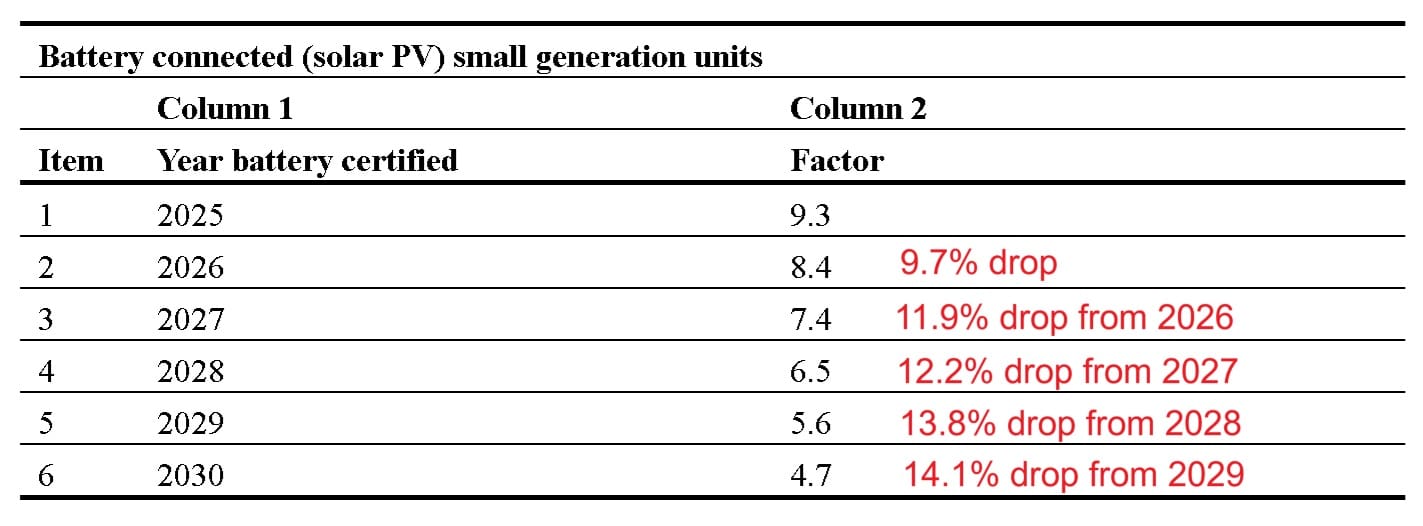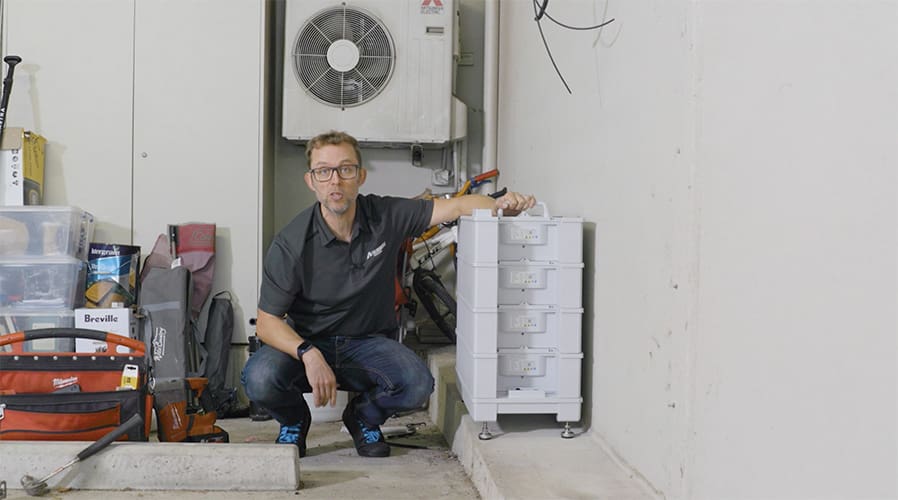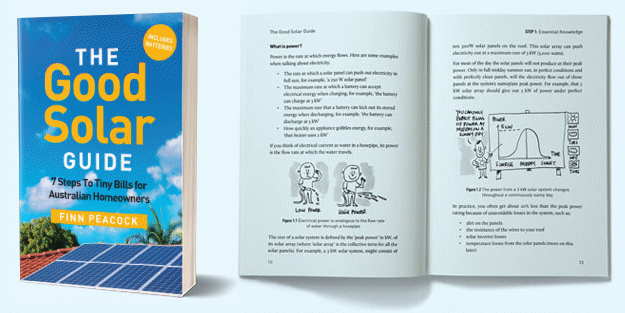
Energy minister Chris Bowen spruiks Labor’s battery election promise.
The federal government has scrambled to the finish line just in time for its $2.3bn Cheaper Home Batteries Program, amending regulations to make official a plan to reshape Australia’s energy grid with the install of one million batteries by 2030.
Since securing reelection in May, the Albanese government has been racing to get the federal battery rebate in place for its promised start date of July 1, with expectations that the program will shave roughly 30% off the cost of a battery.
With just days left before the program was due to kick off, the Renewable Energy (Electricity) Amendment (Cheaper Home Batteries Program) Regulations 2025 have been signed off on by Governor‑General Sam Mostyn.
The amendment enables solar batteries to be eligible under the Small-scale Renewable Energy Scheme (SRES) that is already in place for solar, allowing Labor to avoid a messy fight in parliament to pass legislation that would have been needed for a totally separate battery program.
By attaching the battery rebate to the existing scheme however, it means that households will also need to already have or get a solar system to qualify – batteries installed in homes without solar will not be eligible for the rebate.
The scheme aims to radically ramp up household energy storage capacity – although there are more than 4 million rooftop solar PV systems in Australia, only one in 40 households have batteries.
How Much Is The Battery Rebate Worth?
The rebate is worth a maximum $372 per kWh in 2025, provided by 9.3 small-scale technology certificates (STCs) per kWh of usable capacity. This should shave roughly 30% off the cost of a battery.
One key detail is the rate at which the rebate value is expected to decline over time – the regulations reveal this will happen slower than for the solar rebate.
While solar STCs will reduce by 16.7%, battery STCs will only fall by 9.7% at the end of this year and then by a roughly similar amount each year.
“This means there’s less of a rush to get a battery installed this year, because there will be a less than 10% fall in number of STCs provided next year … all else equal, batteries will only rise in price by around 3%. If suppliers further reduce battery prices as expected however, this means they could be cheaper next year. But if you are likely to save money by installing a battery, there’s little point in waiting,” says SolarQuotes resident fact-checker Ronald Brakels.

The value of the rebate will drop slower than for solar, starting with a 9.7% decline in 2026.
What Are The Eligibility Requirements For The Battery Rebate?
The amendments to the regulations lock in the following eligibility requirements for the Cheaper Home Batteries Program:
- A single solar battery system with a nominal (total) capacity of 5 kWh to 100 kWh will be eligible, but only the first 50 kWh of usable capacity will be discounted;
- Existing batteries can be expanded, provided that the battery system has not previously received a discount under the program, the additional capacity is at least 5 kWh, and the total upgraded capacity of the battery does not exceed 100 kWh in nominal capacity;
- Only one battery system is eligible for a property, and the rebate can only be claimed once per property – so someone with multiple properties could potentially install or upgrade multiple batteries;
- Retailers will need to provide assurance that they believe the battery will be installed for permanent use, and would not be moved or on-sold.
- Batteries can be off-grid or connected to the grid, but in the case of the latter, they must also be Virtual Power Plant (VPP) capable (this doesn’t mean battery owners must actually join a VPP).
One thing homeowners need to be sure of is that they choose hardware and an installer with the appropriate credentials to be eligible:
- Installers are required to be accredited for battery installation by Solar Accreditation Australia;
- Batteries must be listed on the Clean Energy Council-approved product list, which currently only includes lithium batteries, excluding other competing technology types;
- The same goes for new inverters, but you’re using an existing inverter it does not have to be on the approved list, however you do have to ensure it is not included in the product recall list.

Sungrow batteries were voted by SolarQuotes installers as the equal best brand for 2025 (in a tie with Tesla), offering the benefit of modular design which can be expanded in 3.2 kWh increments.
How Do You Claim The Battery Rebate?
Homeowners don’t actually need to do anything to claim the rebate – as has long been the case for solar, installers will apply for the rebate and deduct it from the total system price.
Applications to create STCs for solar batteries are now available in the Renewable Energy Certificates Registry, however applications cannot be submitted until the start date of July 1.
What About Batteries Installed Before July 1?
When Energy Minister Chris Bowen first announced the scheme as an election promise, he assured the clean energy industry that it would be made retrospective to avoid a “valley of death” where people held off on battery purchases until July 1, provided the batteries weren’t turned on until that date.
The rules for installations made before the start date have turned out to be quite strict. Solar battery systems must only have been tested as capable of storing or discharging energy after July 1, as shown on the state/territory certificate of electrical compliance. Solar batteries tested and certified before then won’t be eligible.
Does The Federal Rebate Stack With State Schemes?
In theory, yes. In practice however, most state incentives have wound up since the federal scheme was announced. The WA battery rebate, which also kicks off on July 1, is one exception, although it has been substantially watered down.
Do Your Homework Before The Rebate Launches
To get ready for the federal battery rebate launch on July 1, take a look through our comprehensive batteries guide, and sign up to our weekly newsletter for a special rundown on the scheme on the morning that it launches.

 RSS - Posts
RSS - Posts



Thank you for acknowledging the discrimination against any battery technologies that aren’t lithium. It is hard to compete in a market where the CEC have effectively locked out any non-lithium batteries from getting rebates for a long time even if other batteries have been commercially proven before lithium batteries even came on the market.
I still don’t think I have a way of adding to my Powerwall 2, without using another Powerwall 2. I have micro-inverters. Anybody know if there are ways to add to a Powerwall 2 household with another brand’s battery?
The market for second hand power wall 2 is hot right now. You can either buy one second hand (if you can find an installer who will warrant it) or you could sell yours and go to another product.
I would not recommend mixing brands.
The best option is to keep it all under one brand. It will get complicated and your monitoring will suffer if you mix another brand into your Tesla System.
I’m surprised Tesla isn’t still making them as add-on for those who already have a P2. I get that they want people buying a new Powerwall to go with the P3, but there’s a big market out there of people with the P2.
My installer offered an additional P2 multiple times leading up to the launch of the new rebate, but I couldn’t really justify it so it’s also no real issue for me. The only time of year we’d use the extra storage is winter, and there isn’t enough sunshine here to fill 2 P2s a day anyway. At the moment I use cheaper grid rates to supplement, but they may not last anyway.
I’m in the same position. I have a microinverter based system plus a Powerwall 2. I want to increase battery capacity but am at a roadblock?
Yeh there’s nothing really, except another P2, or a different brand but then each battery has to be set up more or less independent of the other.
For now I look at it another way, I use the single P2 coupled with cheap or free retail grid rates, which act like a second huge battery for the home. The P2 is charging twice a day, once with solar, the rest from the grid.
Seems to me that with payback periods of 6-8 years in Brisbane, this is still a waiting game until battery prices come down to nearer that of EV battery per kWh pricing, and electricity prices increase further – maybe 2026? Also considering the other install costs due to scarcity, labour and non-rebate hardware that need more competition.
Your assumptions are probably right but there are a few things you need to consider that make a huge difference to the payback. Because you can also claim STCs on extra solar panels and the battery will typically have a hybrid inverter capable of accepting up to twice its rated kW peak power then that can bring the upgraded system payback down to 4-years. Let’s say you currently have a 5kW solar inverter with 5kW of panels that was installed 10-years ago. You decide to install a Tesla powerwall 3 or another brand battery/inverter and you can get STC rebates on 20kW of new more efficient panels. The STC rebates are paid per panel so the new panels are free and you can sell the old ones or give them away. The battery will still have the same STC rebates as not having any panels added but you solar system is 4 times bigger for almost no additional cost. If you add to that the fact you could get paid as a VPP it looks better again.
You lost me with “the new 20kW panels are free”, could you please elaborate?
And also a breakdown of your 4y return scenario?
STC certificates are paid on a per panel or per kW basis. The limiting factor is either the 100kW cap per property or the max rating of your inverter (or in this case the Tesla battery/inverter). If you consider the fixed cost of a system is the Tesla Powerwall and the install cost the marginal difference between installing 3kW of solar panels or 20kW of solar panels is negligible because the STC certificates are close to equal the cost of the panels assuming you don’t hit the 100kW of panel limit. It means often it is worth even installing panels on south facing roofs. Under low light conditions, like cloudy, foggy or overcast days the light is diffused and regardless of the direction of the panels they will produce the same amount of electricity-about 10-15% of its theoretical peak. Chances are thats when you need the power too.
What a nasty sting in the tail! “Solar battery systems must only have been tested as capable of storing or discharging energy after July 1, as shown on the state/territory certificate of electrical compliance. Solar batteries tested and certified before then won’t be eligible.”
Have to say this seems quite unreasonably strict, if testing alone blocks the rebate. Isn’t testing done as part of the basic installation process?
If you know what you are doing you can get a quality name brand 5kWh battery from China direct for $1200, delivered.
Rebate is just going to line the pockets of local supply chain.
Hi
The 372$ rebate contains admin charges as per my understanding. What is the actual per KW that the end user can see? Is that dependent on the installer or is it the same across all?
It’s based on what the installer offers you for each STC. For 2025, 1kWh of usable battery capacity creates 9.3 STCs. Say you get a 10kWh (usable) battery installed – this will create 93 STCs. Most installers will offer $35-38 per STC after deducting admin fees etc, so your rebate/discount might be say $36*93 = $3348 on that battery for a particular installer.
Quotes should show the number of battery STCs and the price they are offering per STC. If there are solar panels being installed as part of the same quote, the panel STCs will typically be priced the same.
NSW homeowners need to know that their older homes will need to be upgraded to current electrical standards.
It means you will need a current smart metre.
After upgrading the powerboard, at the homeowners cost, $2000.00 upwards, the smartmetre is free.
No supplier seems to advertise this additional cost.
I found out after installation of battery. $2500
Peter
What’s a smart metre? Is it around 39.3 inches?
Hint: You mean smart METER.
A metre is length, a meter measures electricity (and other things).
If you currently have a Sungrow inverter and need to upgrade to hybrid for battery install have a look at this.
https://service.sungrowpower.com.au/how-trade-in-works
Here are Sungrow rebates for trade in models when upgrading to hybrid inverter with batteries. I’m on it!
Rebate Amounts
Model
Trade-in Value
(exGST)
SG2K-S
$500
SG25K5-S
$550
SG3K-S
$600
SG3K-D
$650
SG5K-D
$800
SG8K-D
$1,000
SG2.0RS-S
$650
SG3.0RS
$750
SG5.0RS
$1,000
SG5.0RS-ADA
$1,100
SG8.0RS
$1,300
SG10RS
$1,500
Model
Trade-in Value
(exGST)
SG5KTL-MT
$900
SG10KTL-MT
$1,000
SG15KTL-M
$1,100
SG20KTL-M
$1,200
SH5K-20
$1,050
SH5K-30
$1,100
SG5.0RT
$1,300
SG7.0RT
$1,350
SG8.0RT
$1,400
SG10RT
$1,500
SG15RT
$1,600
SG20RT
$1,700
So am I right that there appears to be very little restrictions for off grid? Earlier statements seemed to indicate a minimum distance from the grid was required before it was eligible?
Dont forget the gst of 10%
and you need a secure wireless connection (at your own cost), enough spaces on your current switch board , and it must be installed by accredited supplier of listed batteries.
good luck everyone.
Yep did all that no problem system installed on the 1st of May battery installed but not tested so far so good, I had no idea the federal government would do this and was only relying on the state government for the rebate so this has been a huge bonus 😎
I have not paid an electric account for 11 years now, so why would I pay for batteries made in China that are likely to burn out.
Hi Brian,
Zero bills are unusual these days. What is your feed in tariff like? Fully 90% of the world’s solar comes from China these days and even batteries made in Australia source cells there.
Firstly, love your work Fin.
You need to address additional requirements regarding off grid systems.
“Apparently” you need to be further that 1km from the nearest power pole, or cost more than $30 000 to connect. So I contacted AusNet (Victoria) and requested a quote. $550 thank you.
Hi Gareth,
Here in SAPN land they will give you an indicative price for free last I checked, but private for profit utilities are generally just that.